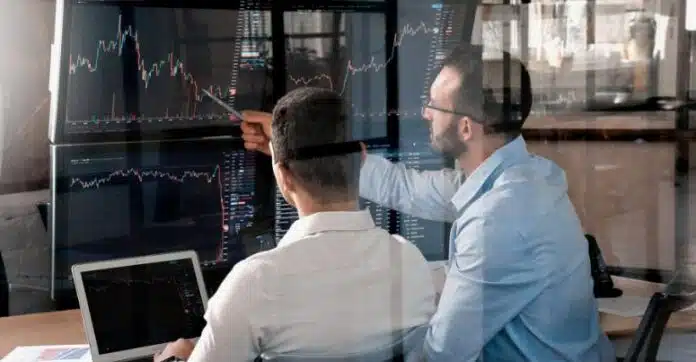
One of the key tips for beginners looking to dive into forex trading in the UAE is to read up on how exchange rates work. They should also familiarize themselves with major global currencies and understand what makes them fluctuate in value. Understanding market analysis tools such as charting, support/resistance levels, pivot points, trend lines, Fibonacci retracements, and MACD may help those starting to optimize their trade entries and exits.
Proper money management techniques are a must when engaging in forex trading activities. Setting stop-loss orders can minimize risk when doing short-term trades or scalping strategies involving high-leverage accounts. Additionally, traders should employ a risk-reward ratio strategy to set an acceptable worst-case loss level on each trade while aiming for bigger wins that could make up moderate losses incurred earlier.
Knowing basic concepts and strategies and equipping yourself with the right tools are essential to succeed in forex trading. Various sources of information such as books, magazines, websites, and TV shows can provide a wealth of knowledge that operators should become familiar with before engaging in real trading. Understanding economic forces and how they affect currency values is critical for efficient trading decisions. For traders who prefer interacting directly with other investors or searching for better trade opportunities, this means having access to reliable resources.
Understanding Forex Trading
Forex trading is the simultaneous buying and selling of currencies to make a profit. This involves analyzing economic data, monitoring news stories, and assessing market dynamics for different currency pairs. It also requires knowledge of various financial instruments to take advantage of short-term price changes in foreign currencies with minimal risk. In addition to its inherent risks, forex trading can be profitable if the trader has access to advanced tools such as charting programs, analysis software, and automated trading systems, which can analyze real-time price movements and quickly identify potentially profitable opportunities. Expert traders use specialized strategies with discipline to limit their losses while making profits from favorable exchange rate fluctuations.
The forex market is an international marketplace for trading currencies. It allows anyone to buy or sell any currency at any given time, and there are no barriers to entry—no central exchange or clearing house where all trades occur. Instead, currencies are traded through a global network of banks, dealers, and brokers. When someone wants to buy a currency, they place a trade order with their broker that specifies which pair of currencies they want and the desired exchange rate between them. The broker then looks for another trader interested in selling that pair at that rate; if found, the two traders agree on the terms of their deal — known as a “transaction” — before executing it immediately. This kind of decentralized market ensures liquidity: nobody controls it since everyone buys and sells independently from each other directly within the market.
Leverage is using borrowed capital to increase potential returns on financial investment. Margin is the initial money an investor deposits when entering a trading position or making a trade. Long positions involve buying currencies at lower prices, anticipating value will appreciate over time. In contrast, some investors open their trades ‘short’ to benefit from declines in market prices for corresponding currency pairs. A currency pair consists of two different currencies traded against each other, determining their respective exchange rate values relative to each other. Advanced traders may also use more complex strategies, such as hedging and arbitrage, to exploit price discrepancies between markets (e.g., spot forex vs. futures).
The foreign exchange market provides many trading strategies to accommodate different types of traders. The most common are long-term, swing trading, and day trading. Long-term traders prefer to hold trades for several months or more to profit from larger swings in the currency markets. Swing traders usually attempt to capture smaller price movements over a shorter time than long-term traders but remain with their positions for longer periods than day traders do. Day traders try to take advantage of quick intraday fluctuations by closing their positions each night before the market closes. Other strategies involve using fundamental analysis and technical indicators such as moving averages, support/resistance levels, Fibonacci ratios, and momentum oscillators.
Setting up a Forex Trading Account
A reputable broker will offer a wide range of services, attractive spreads, and provide access to deep liquidity for efficient executions. They should also be available around the clock for customer support, respond quickly to queries, and ensure speedy withdrawals when required. When searching for a suitable forex broker in the UAE, it is important to consider cost and quality; there are no trade-offs here, as having both would prove beneficial in the long run.
Professional traders can benefit from direct-market access through ECNs or electronic communication networks, while casual traders may opt for more popular platforms such as MetaTrader 4 and cTrader that come with intuitive charts plus extra features like automated trading robots (EAs).
Lastly, check if your preferred forex broker offers Islamic accounts that do not charge interest or swaps on trades done overnight – these types of accounts are often tailor-made for Muslim investors, ensuring that their trading activities remain within Shariah Law parameters.
There’s a host of documents that all UAE forex brokers need from their clients before an account is opened and money can be deposited into trading accounts. This includes
- Passport copies,
- Utility bills,
- Bank statements,
- Proof of income or employment, and other financial documentation needed by each broker.
The account types include mini accounts, micro accounts, and VIP accounts. Mini Accounts require a lower minimum deposit amount and offer tighter spreads than Standard Accounts but fewer features, such as no automatic maintenance or trades limit.
Micro Accounts are ideal for aspiring forex brokers in UAE who wish to start trading with limited capital investment but do not want to be exposed to too much risk at once due to their small trade sizes. They also provide traders with access to advanced charting tools and analysis software without incurring extra charges associated with larger forex brokers’ services like API integration costs into their platforms.
Lastly, VIP Accounts are best suited for experienced traders looking for personalized service experiences, such as specific guidance on strategies that big banks use to predict price movements and sophisticated liquidity providers that increase flexibility when placing orders in volatile markets while reducing slippage caused by requotes common among smaller brokers.
The most common method is linking a bank account directly to the broker’s platform, allowing them to transfer funds electronically. Money can also be wired from a bank account or deposited with certified checks or money orders added directly to the investor’s cash balance. Generally, those who trade stocks will use market orders regularly when buying and selling securities in the stock exchange, whereas limit orders give investors more control over their transactions as they set limitations on how much is spent per share.
Developing a Forex Trading Strategy
Having a trading strategy is absolutely essential to success in the stock market. A trading strategy ensures that you approach the market with a well-thought-out plan and risk management rules, rather than blindly buying and selling shares without any sense of reason or logic.
A good trading strategy helps you identify potential opportunities for generating profits in the markets by allowing you to establish criteria for selecting which stocks to buy and sell, determine appropriate entry points into trades, as well how much money should be invested per trade.
It also allows traders to manage emotions better when participating in risky investments such as day trading or margin trading since they are following predetermined parameters rather than making highly subjective decisions based on gut feelings alone. Ultimately, having a successful trading strategy means less stress and fewer losses – something every trader strives for!
Fundamental analysis focuses on the larger economic picture to determine underlying trends in the market that can help traders identify long-term buying or selling opportunities. Technical analysis utilizes mathematical models to analyze historical price action to anticipate future movements.
Money management is critical for managing trading risk by setting position sizes relative to the size of the capital left in your account after each losing trade. With these key elements, traders can develop a trading strategy tailored specifically to their individual financial goals and objectives. In addition, developing a sound trading plan is important for any successful trader; this includes identifying entry and exit points with clear rules applied across different markets or asset classes in order to ensure consistent returns over time.
Successful traders often deploy multiple strategies with different timelines based on their specific goals: from short-term day trades all the way up to long-term holding periods of months or years depending on investor preferences and the level of patience/risk tolerance required to deliver gains beyond buy and hold investing methods during volatile markets cycles without overexposing one’s capital portfolio too much risk compared against net worth at stake at any given point along journey’s path forward into uncertain futures!
From momentum trading and scalping to range trading, breakout strategies, and even algorithms that employ complex mathematical models, there is no shortage of approaches one can take. For the beginner trader, however, it’s important to focus on honing your skills in one or two basic strategies until you have fully mastered them. This includes learning how to properly interpret price action data and read technical analysis charts as well as developing an understanding of different market conditions like trending forex pairs or sideways-moving stocks.
Of course, the basics include managing risk – when beginning out try not to expose too much capital each time you enter a new position. By mastering these few basics first you will already be ahead of most traders who scramble around from strategy to strategy trying desperately just to keep their heads above water!
Trading Psychology
Having the right mindset can help traders remain in control even during high volatility and difficult market conditions. Forex trading psychology should include developing a plan for dealing with emotions such as fear and greed, keeping negative thoughts at bay, learning from past mistakes, and being focused on the present moment.
Trading psychology is also about cultivating a positive attitude towards risk-taking that emphasizes patience, discipline, sound money management principles, and overall respect for the markets. By integrating these core concepts into your routine as an FX trader, you will become better poised to make successful trades while remaining emotionally balanced.
Too often, new traders will jump into the markets without researching the underlying asset, platform, or trading strategy. This can quickly lead to losses that could have been avoided with a few moments spent learning more about the markets before diving in blindly. Over-trading is another common mistake, especially among novice investors; it’s important to resist buying and selling too frequently as this can erode even small profits rapidly due to commissions or fees associated with each trade.
Before entering any position, ask yourself why you are making that move and whether your plan has realistic profitability expectations, given historical data or market conditions. Lastly, emotions should never play a role when trading; members should stay disciplined when entering positions and be willing to take the loss if necessary.
Overtrading usually occurs when traders underestimate how long it can take for trades to work through their positions. This is why it’s important to have clearly defined entry and exit points in a trading strategy before making trades. Not having a plan or not sticking with the one you do have often led to emotional choices that could make things worse rather than better. Finally, leveraged instruments are powerful tools but should never be used without careful consideration of risk management techniques – otherwise, investors can quickly find themselves overextended and in deep losses. Ultimately, all successful trading requires patience, discipline, and an understanding of the markets you’re looking at – so don’t rush into decisions without mindful reflection on these three pillars!
Keep Reading
Which Are the Most Successful Forex Traders in the World?
Risk Management
Understanding how the market works, its various movements, and possible opportunities are critical to realizing profits over time. As a result, traders need to understand risk management techniques, such as evaluating potential trades and considering their risk-reward ratio before execution. This will help them determine whether the potential reward justifies taking on that amount of risk or not.
Additionally, it may be ideal for even more experienced traders to use a protective stop-loss strategy when trading to mitigate any unforeseen losses due to sudden market fluctuations. Finally, regularly monitoring open positions in real-time can also help prevent further losses by closing out a position if one goes against you quickly without giving you sufficient time to react adequately. By using these strategies effectively, traders can better manage risk while engaging in forex trading activities and increase their chances of achieving desired outcomes over time!
A stop-loss order sets a predefined price point at which your trades will be automatically sold if the asset declines below it, risking further losses beyond the established amount. Also, take profit orders and set an upper limit at which your trade will be closed when profits can no longer increase without exposing them to additional downside risk – again ensuring that you don’t exceed previously determined amounts of risk/exposure. These tools are invaluable as they help you stay disciplined and structured when trading volatile securities enabling you to maintain consistent performance over time and maximize profitability while managing risks accordingly.
One effective way to handle losing trades is to immediately identify what went wrong and try to learn from your mistakes. This could include reviewing the chart, analyzing the trade setup again, and running through a mental checklist that allows you to determine if you overlooked anything before entering the trade to prevent similar missteps going forward.
Additionally, it may be helpful to look at your unsuccessful trades objectively by asking yourself, “what would have been different had I done something differently?” Asking this question can provide invaluable instruction and help propel future success as a trader. Another key step in dealing with losses is taking time off after suffering significant drawdowns or multiple consecutive losses, making traders more emotional and prone to overtrading.
Conclusion
Educate yourself on the workings of the forex market, including its history and volatility. Utilize free online educational resources taught by experienced traders to help increase your knowledge of foreign currency exchange markets. Use a stop-loss strategy; set limits for how many losses you will take per trade and stick with them, no matter what happens during trading.
Take advantage of tools such as charting software programs to analyze historical data points, identify trends and make informed decisions regarding entry or exit position points along your investment journey. Above all else, remember that it’s important not to let emotions drive your investments but instead remain calculated to maximize profits while minimizing losses over time.


